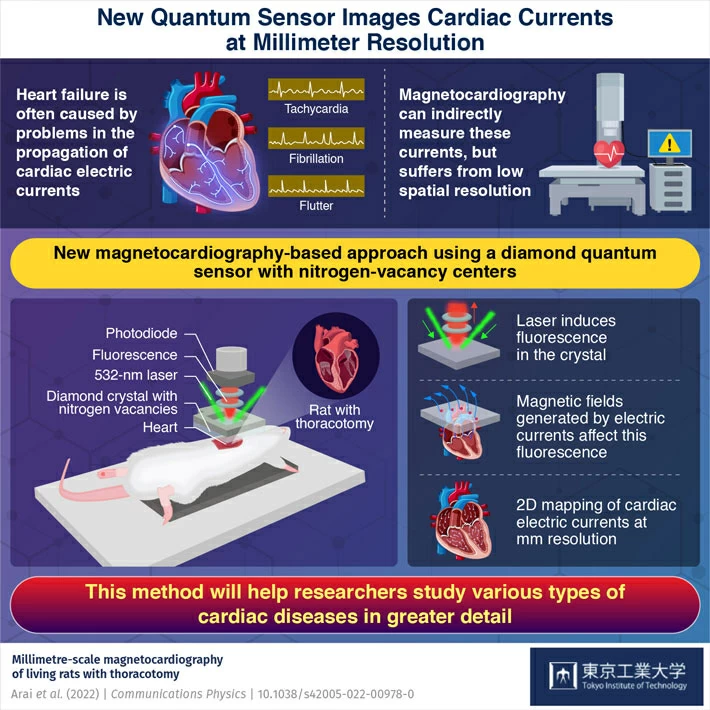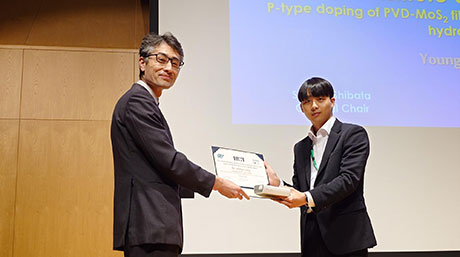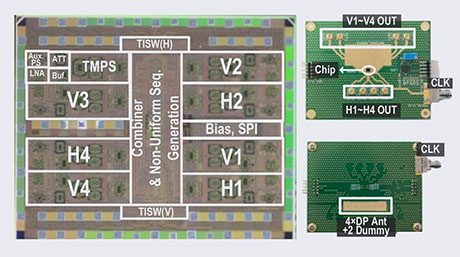Electrical and Electronic Engineering News
Measuring Currents in the Heart at Millimeter Resolution with a Diamond Quantum Sensor
Imperfect current propagation in the heart is at the root of most cardiac diseases. Thanks to a novel magnetocardiography technique developed in the MEXT Q-LEAP Flagship project with researchers from Tokyo Tech and the University of Tokyo, we can now image these currents at millimeter-scale resolutions. Based on a diamond quantum sensor that senses the heart's magnetic fields, the proposed system offers high resolution at room temperature, as demonstrated in experiments with rats. The technique could help deepen our understanding of several cardiac arrythmias.

Heart problems, such as tachycardia and fibrillation, arise mainly from imperfections in the way electric currents propagate through the heart. Unfortunately, it is difficult for doctors to study these imperfections since measuring these currents involves highly invasive procedures and exposure to X-ray radiation.
Luckily, there are other options. For instance, magnetocardiography (MCG) is a promising alternative approach to indirectly measure heart currents. The technique involves sensing minute changes in magnetic field near the heart caused by cardiac currents, which can be done in a completely contactless manner. To this end, various types of quantum sensors suitable for this purpose have been developed. However, their spatial resolution is limited to centimeter scales: not good enough to detect cardiac currents that propagate at millimeter scales. Moreover, each of these sensors has a fair share of its practical limitations, such as size and operating temperature.
In a recent study published in Communications Physics, a team of scientists led by Associate Professor Takayuki Iwasaki of Tokyo Institute of Technology (Tokyo Tech), Japan, have now developed a novel setup to perform MCG at higher resolutions. Their approach is based on a diamond quantum sensor comprising nitrogen vacancies, which act as special magnetic "centers" that are sensitive to the weak magnetic fields produced by heart currents.
But how does one observe the state of these centers to extract information about the cardiac currents? It turns out that the sensor is also fluorescent, which means that it easily absorbs light at specific frequencies and then re-emits them at different frequencies. Most importantly, the intensity of the light re-emitted at the nitrogen vacancies changes depending on the intensity and direction of the external magnetic field.
The research team created an MCG setup using a 532 nm (green) laser to excite the diamond sensor and a photodiode to capture the re-emitted photons (light particles). They also developed mathematical models to accurately map these captured photons with the corresponding magnetic fields and, in turn, with the cardiac currents responsible for them.
With an unprecedented spatial resolution of 5.1 mm, the proposed system could create detailed two-dimensional maps of the cardiac currents measured in the hearts of laboratory rats. Additionally, the diamond sensor could operate at room temperature, unlike other well-established MCG sensors that require cryogenic temperatures. This enabled the researchers to position their sensor extremely close to the heart tissue, which amplified the measured signals. "The advantages of our contactless sensor combined with our current models will allow for more precise observations of cardiac imperfections using small mammalian model animals," highlights Dr. Iwasaki.
Overall, the MCG setup developed in this study appears to be a promising tool for understanding many heart problems as well as other bodily processes involving electric currents. In this regard, Dr. Iwasaki remarks: "Our technique will enable the study of the origin and progression of various cardiac arrhythmias, as well as other biological current-driven phenomena."
Let us hope the team's efforts will help deepen our knowledge about heart diseases, contributing to saving lives through modern medicine.
- Reference
| Authors : | Keigo Arai1,2, Akihiro Kuwahata3,4, Daisuke Nishitani1, Ikuya Fujisaki1, Ryoma Matsuki1, Yuki Nishio1, Zonghao Xin3, Xinyu Cao3, Yuji Hatano1, Shinobu Onoda5, Chikara Shinei6, Masashi Miyakawa6, Takashi Taniguchi7, Masatoshi Yamazaki8,9, Tokuyuki Teraji6, Takeshi Ohshima5, Mutsuko Hatano1,5,*, Masaki Sekino3,*, and Takayuki Iwasaki1,* |
|---|---|
| Title of original paper : | Millimetre-scale magnetocardiography of living rats with thoracotomy |
| Journal : | Communications Physics |
| DOI : | 10.1038/s42005-022-00978-0 |
| Affiliations : |
1 School of Engineering, Tokyo Institute of Technology 2 Japan Science and Technology PRESTO 3 Graduate School of Engineering, The University of Tokyo 4 Graduate School of Engineering, Tohoku University 5 National Institutes for Quantum and Radiological Science and Technology 6 Research Center for Functional Materials, National Institute for Materials Science 7 International Center for Materials Nanoarchitectonics, National Institute for Materials Science 8 Department of Cardiology, Nagano Hospital 9 Medical Device Development and Regulation Research Center, The University of Tokyo |
|
* Corresponding authors' emails: sekino@g.ecc.u-tokyo.ac.jp, iwasaki.t.aj@m.titech.ac.jp |
|
- How Flawed Diamonds "Lead" to Flawless Quantum Networks | Tokyo Tech News
- Artificially introduced atomic-level sensors enable measurements of the electric field within a working semiconductor device | Tokyo Tech News
- New diamond structures produce bright luminescence for quantum cryotography and biomarkers applications | Tokyo Tech News
- Quantum science and technology | Research Stories | Research
- Mutsuko Hatano - Diamonds as the ultimate semiconductors | Research Stories | Research
- Six Tokyo Tech faculty members receive FY2019 MEXT Commendation | Tokyo Tech News
- Associate Professor Takayuki Iwasaki receive FY2019 MEXT Commendation|Electrical and Electronic Engineering News
- Arai Lab (Japanese)
- Hatano & Iwasaki Lab
- Keigo Arai | Researcher Finder - Tokyo Tech STAR Search
- Takayuki Iwasaki | Researcher Finder - Tokyo Tech STAR Search
- Mutsuko Hatano | Researcher Finder - Tokyo Tech STAR Search
- Electrical and Electronic Engineering Graduate Major|Education|Department of Electrical and Electronic Engineering, School of Engineering
- Energy Science and Engineering Graduate Major|Education|Department of Electrical and Electronic Engineering, School of Engineering
- Electrical and Electronic Engineering Undergraduate Major|Education|Department of Electrical and Electronic Engineering, School of Engineering
- Department of Electrical Engineering and Information Systems, Graduate School of Engineering, The University of Tokyo
- Latest Research News
School of Engineering
—Creating New Industries and Advancing Civilization—
Information on School of Engineering inaugurated in April 2016
Further Information
Associate Professor Keigo Arai
School of Engineering, Tokyo Institute of Technology
Email arai.k.ar@m.titech.ac.jp






